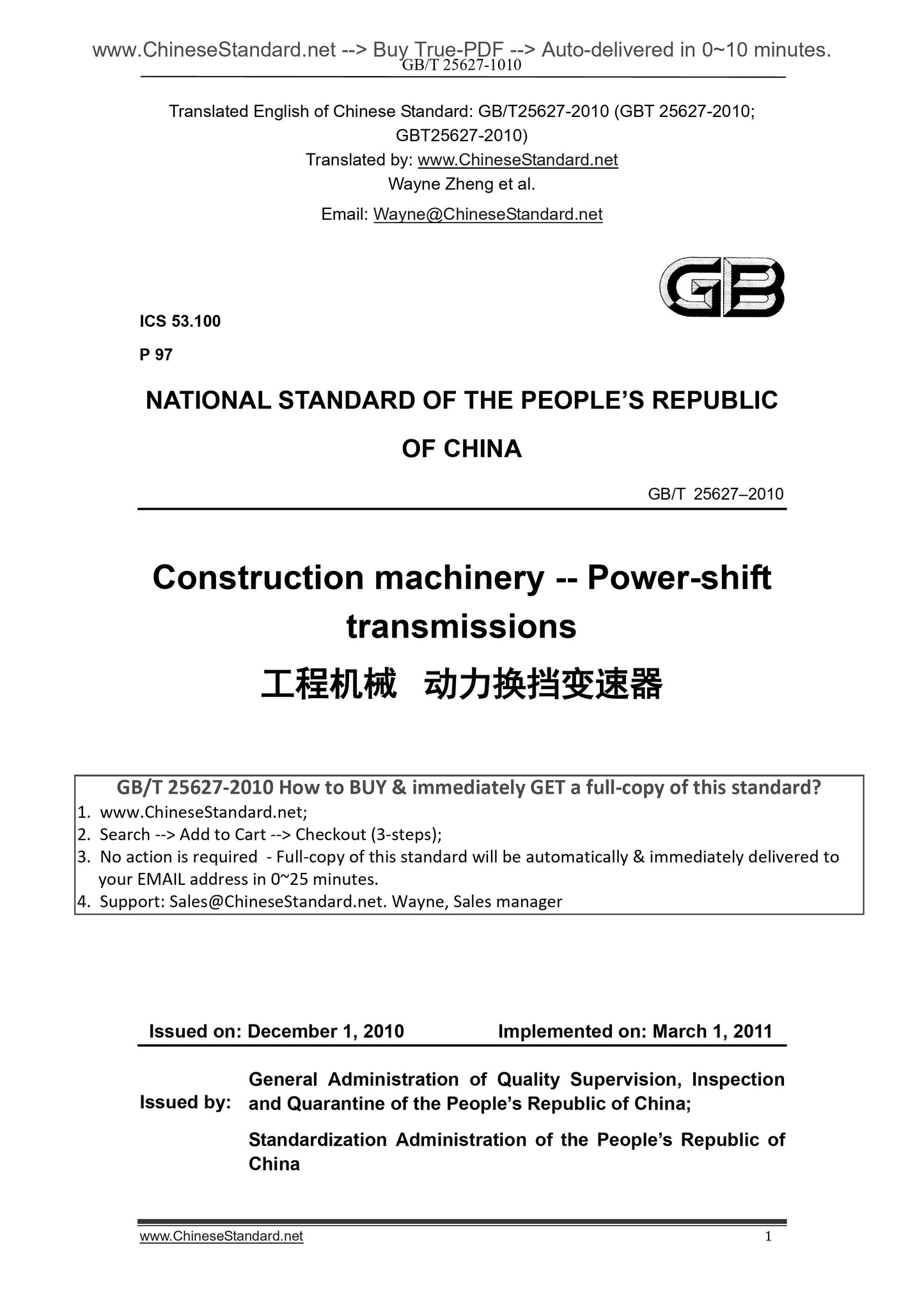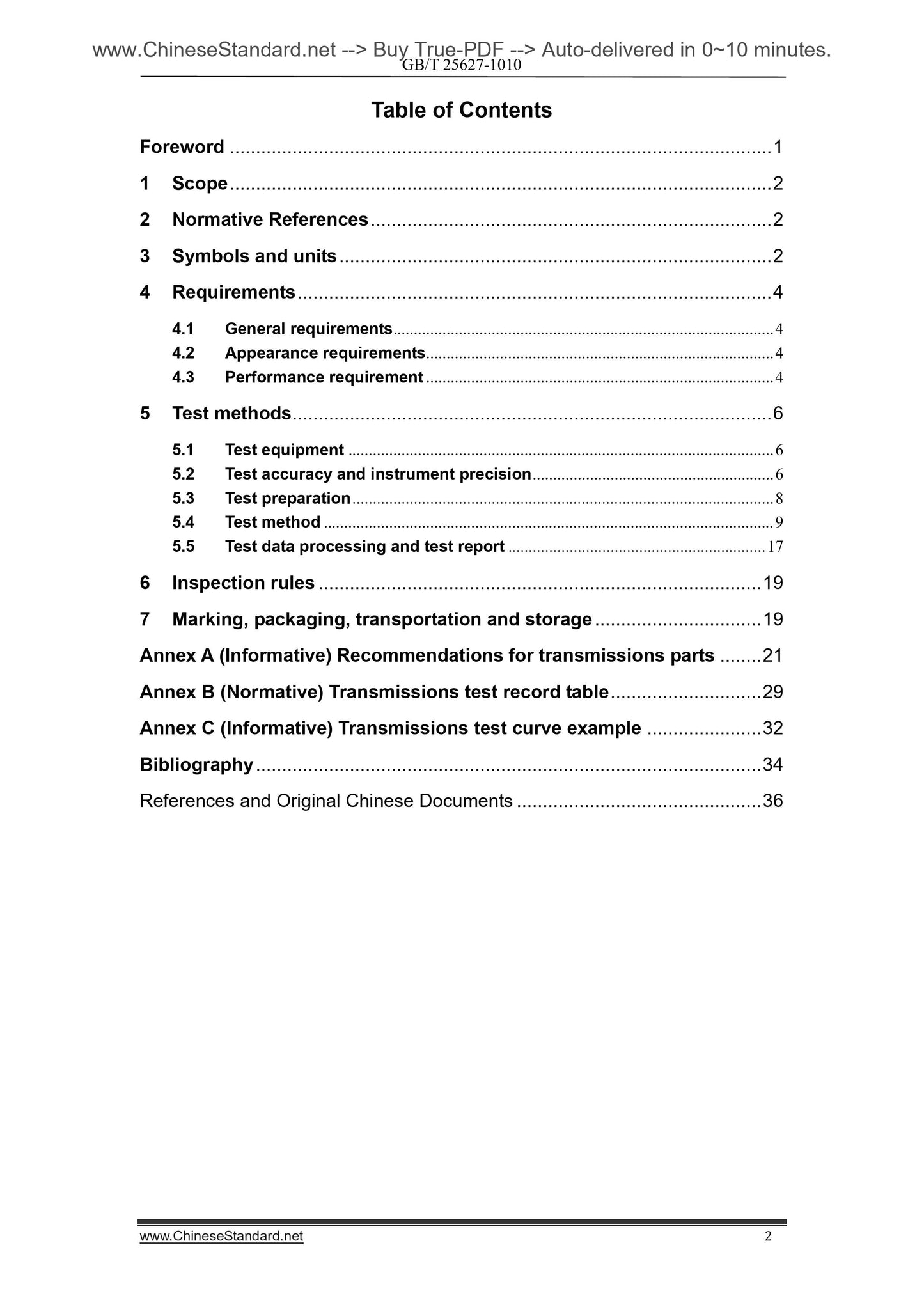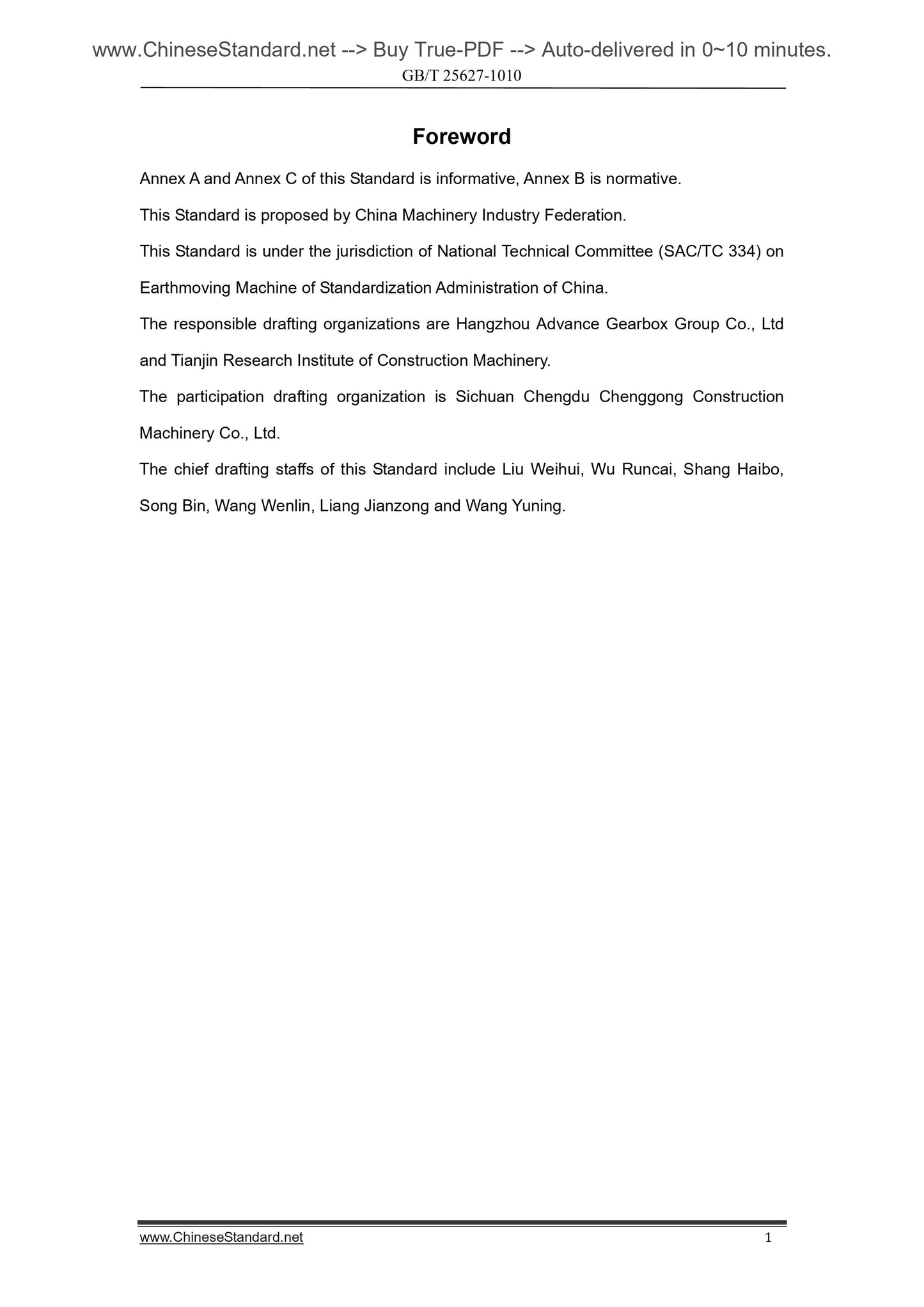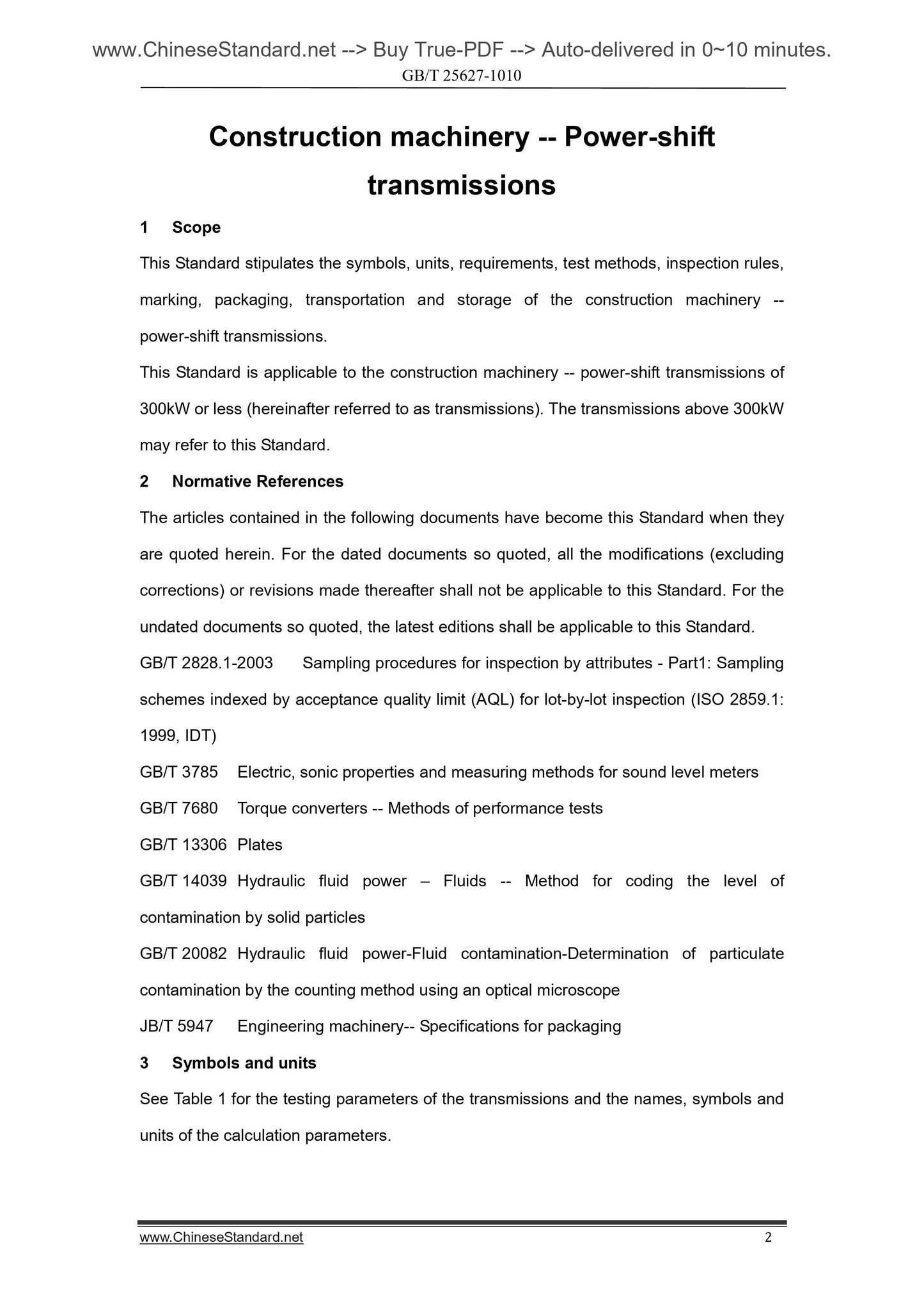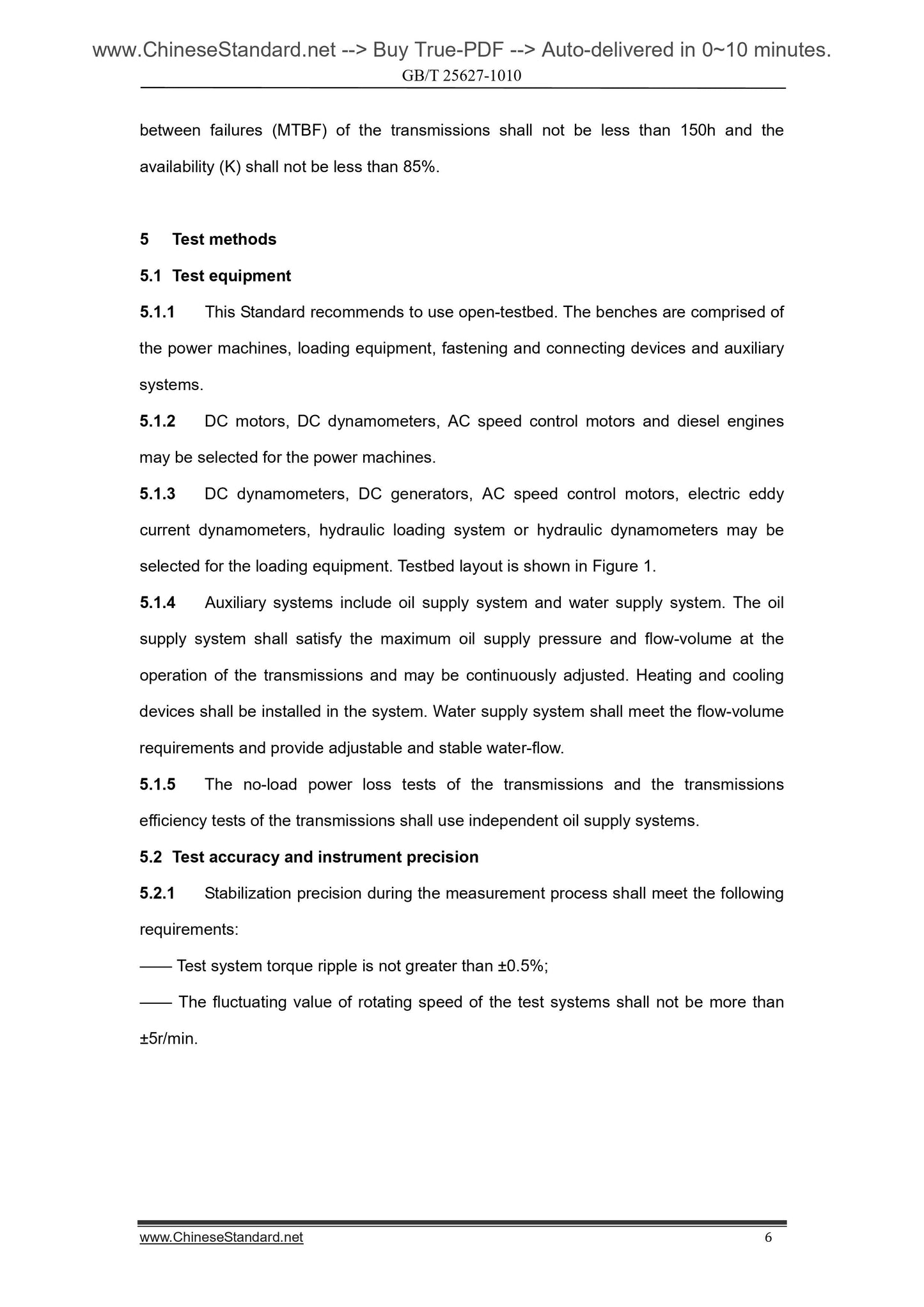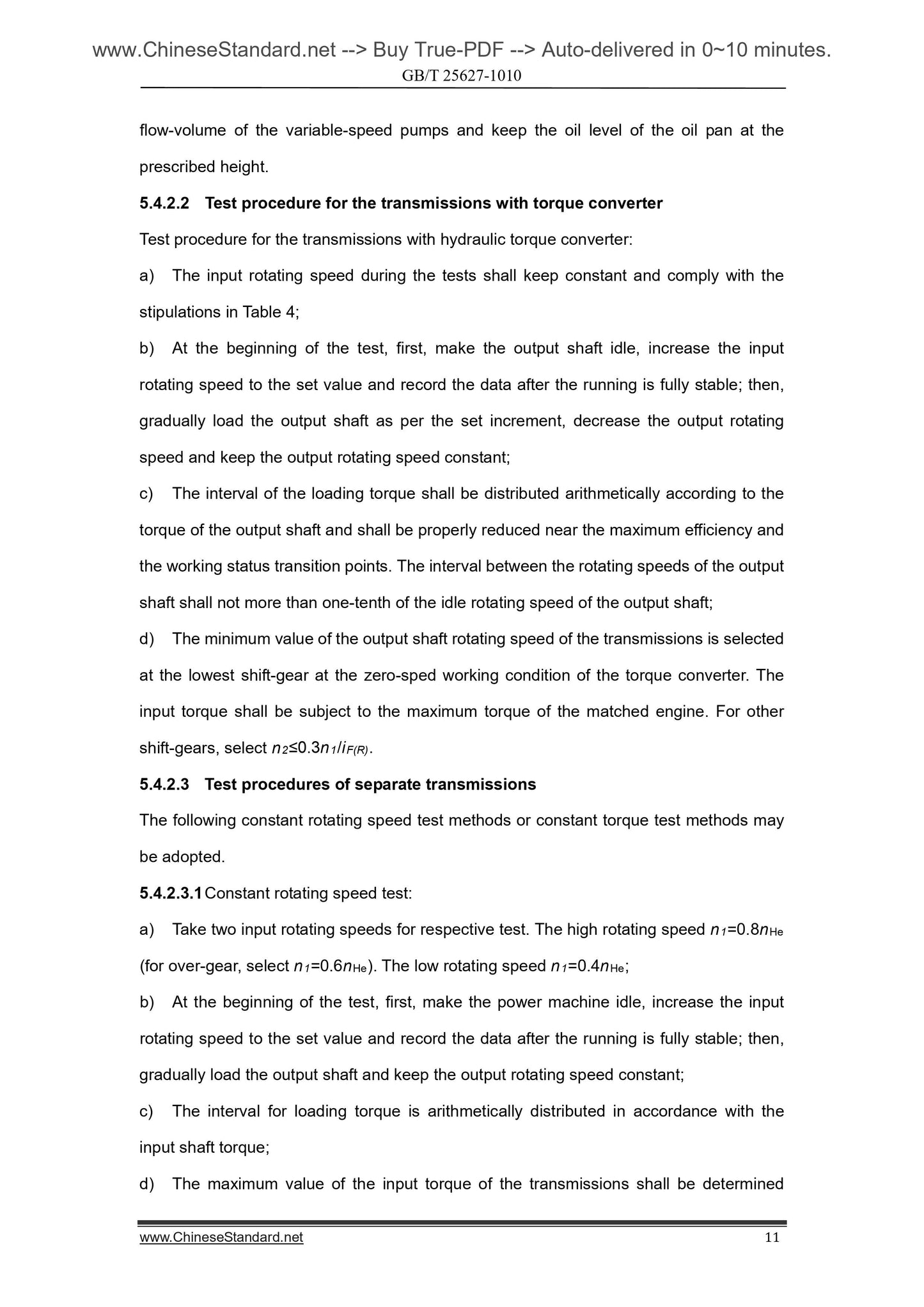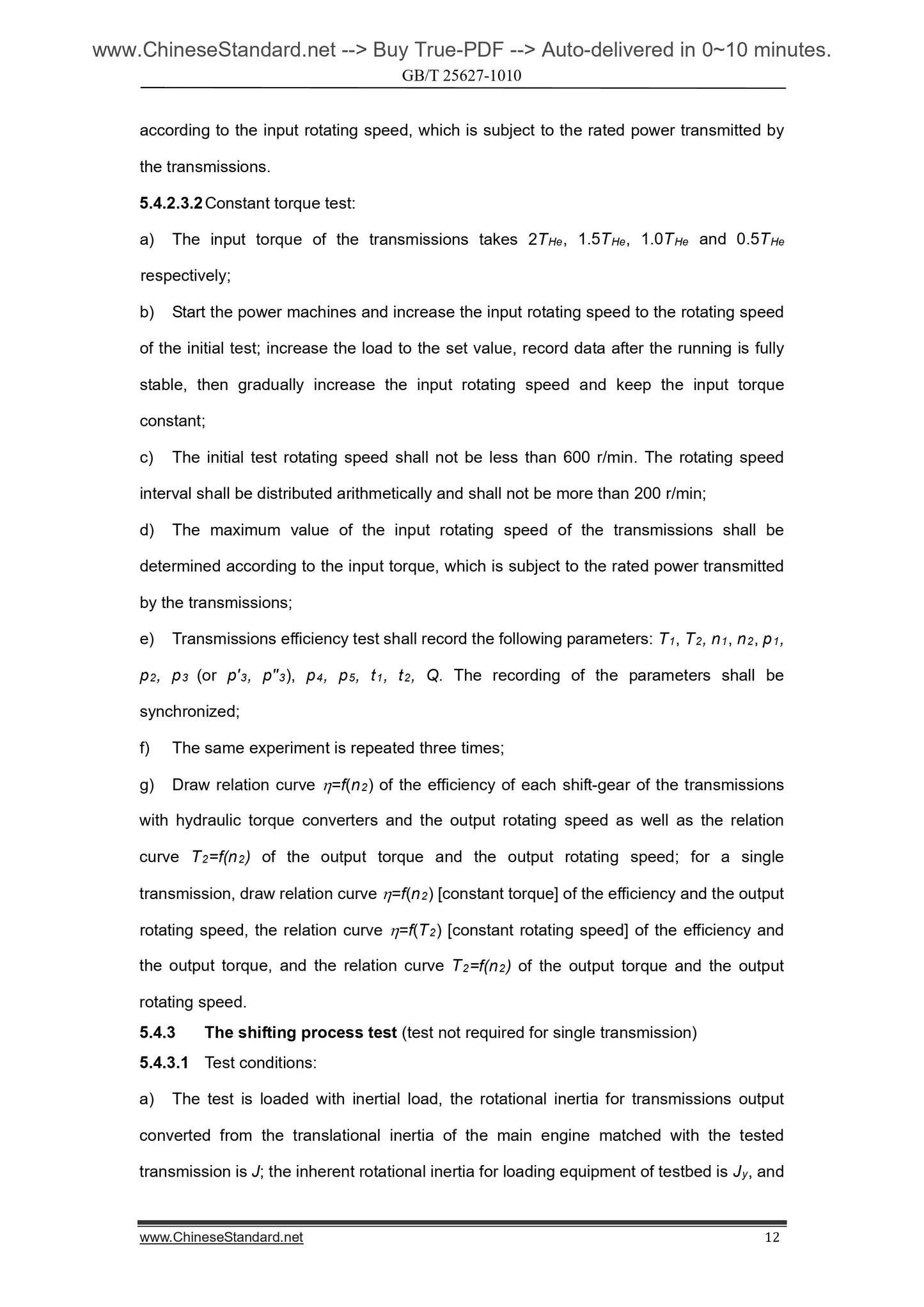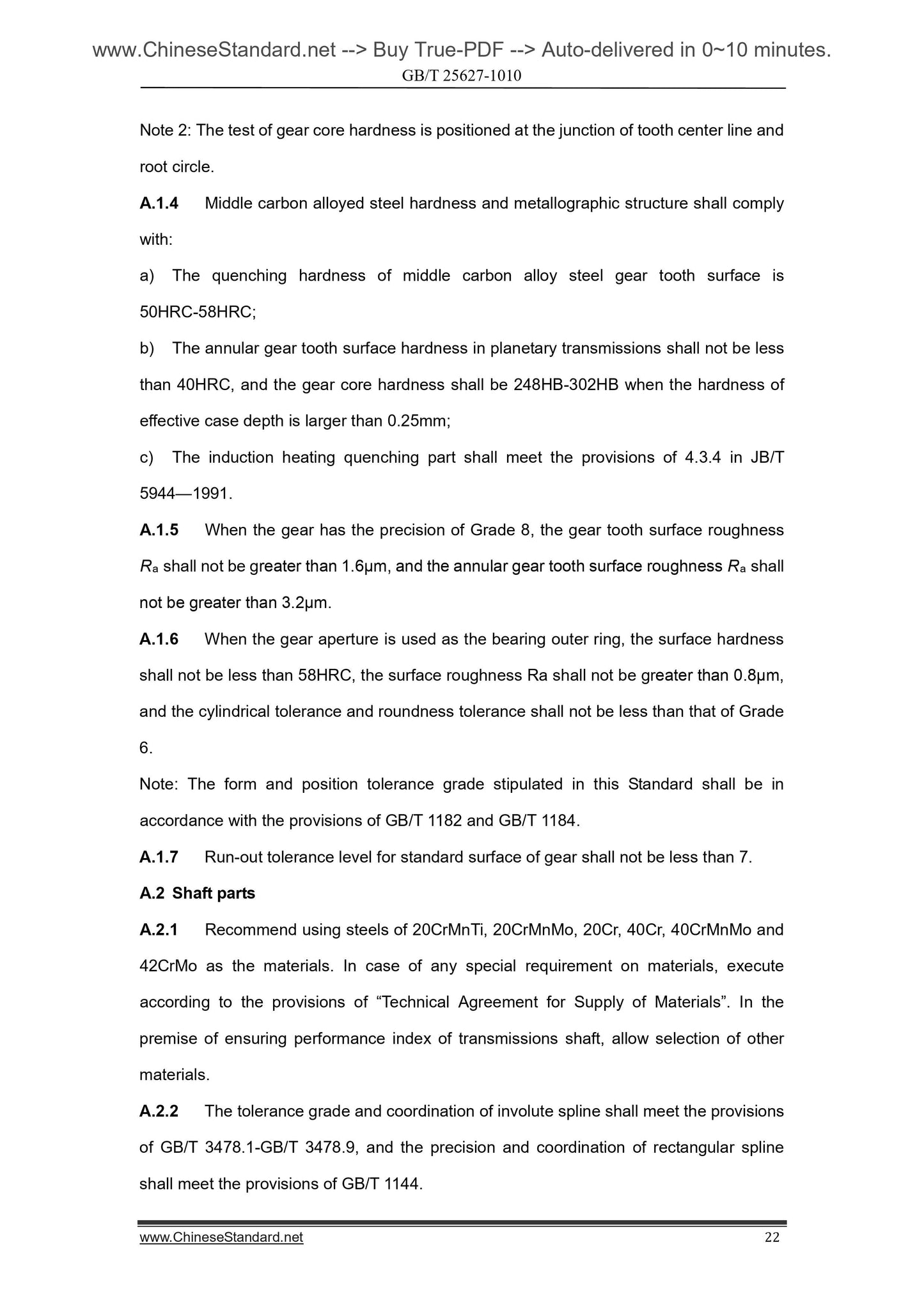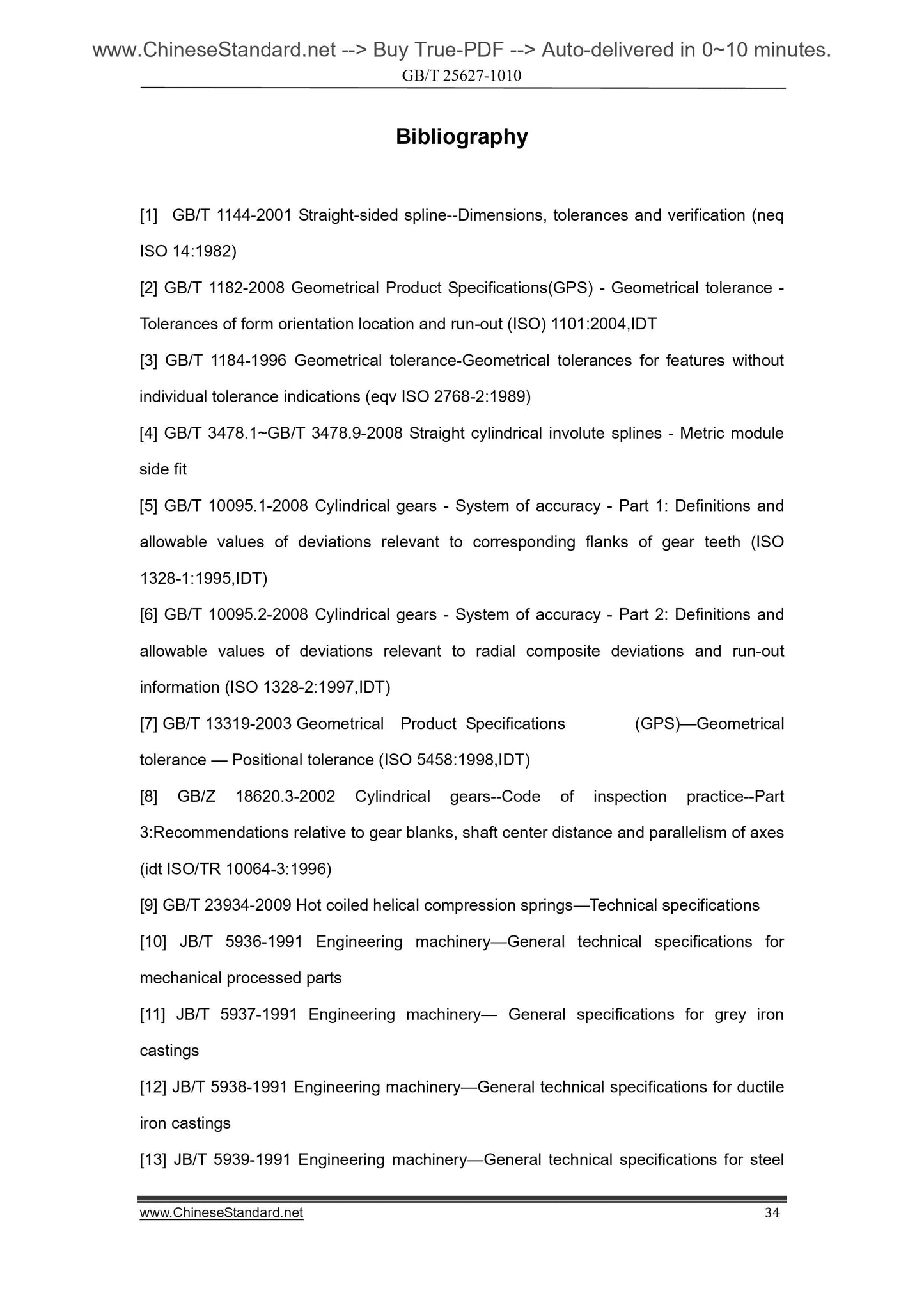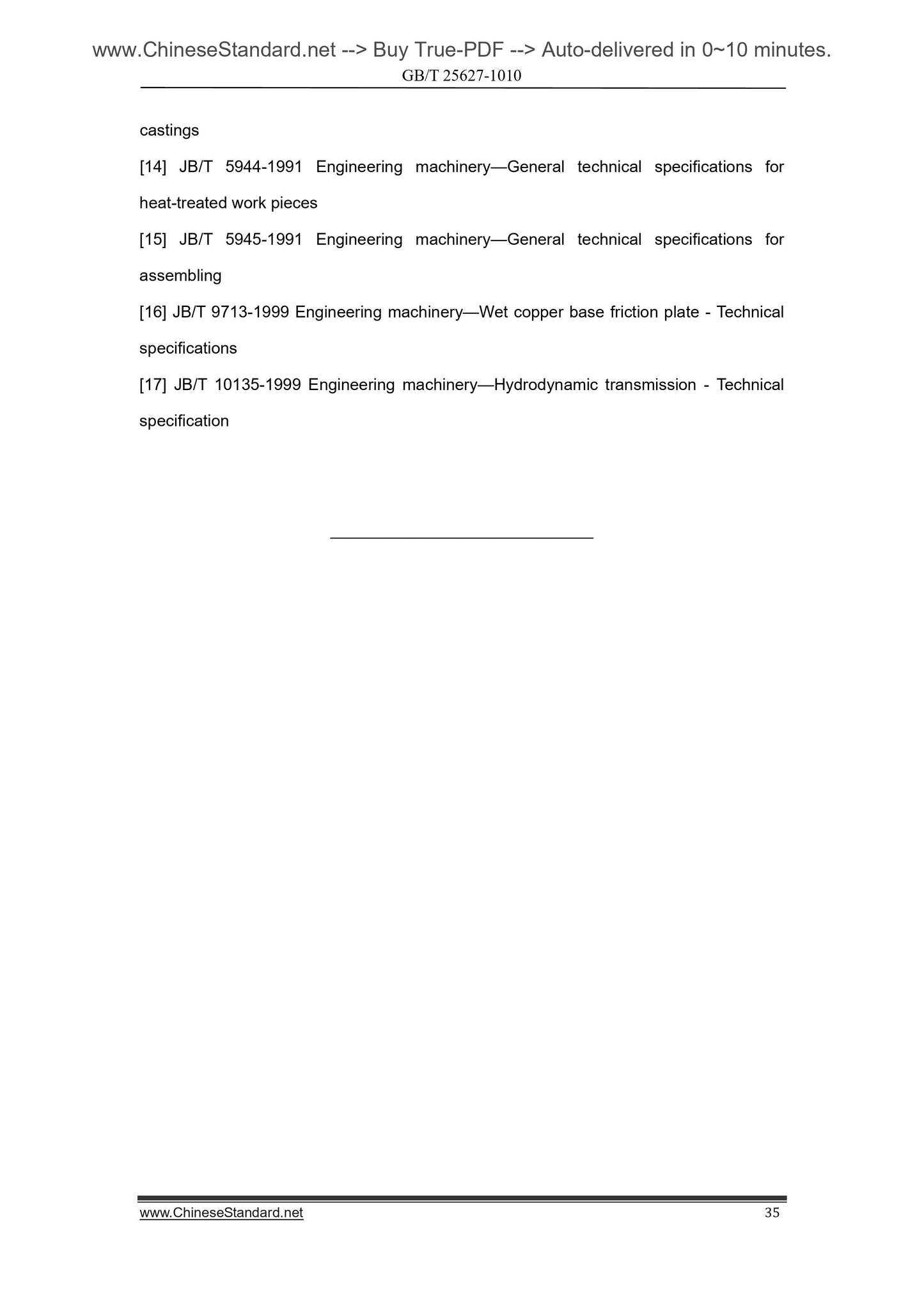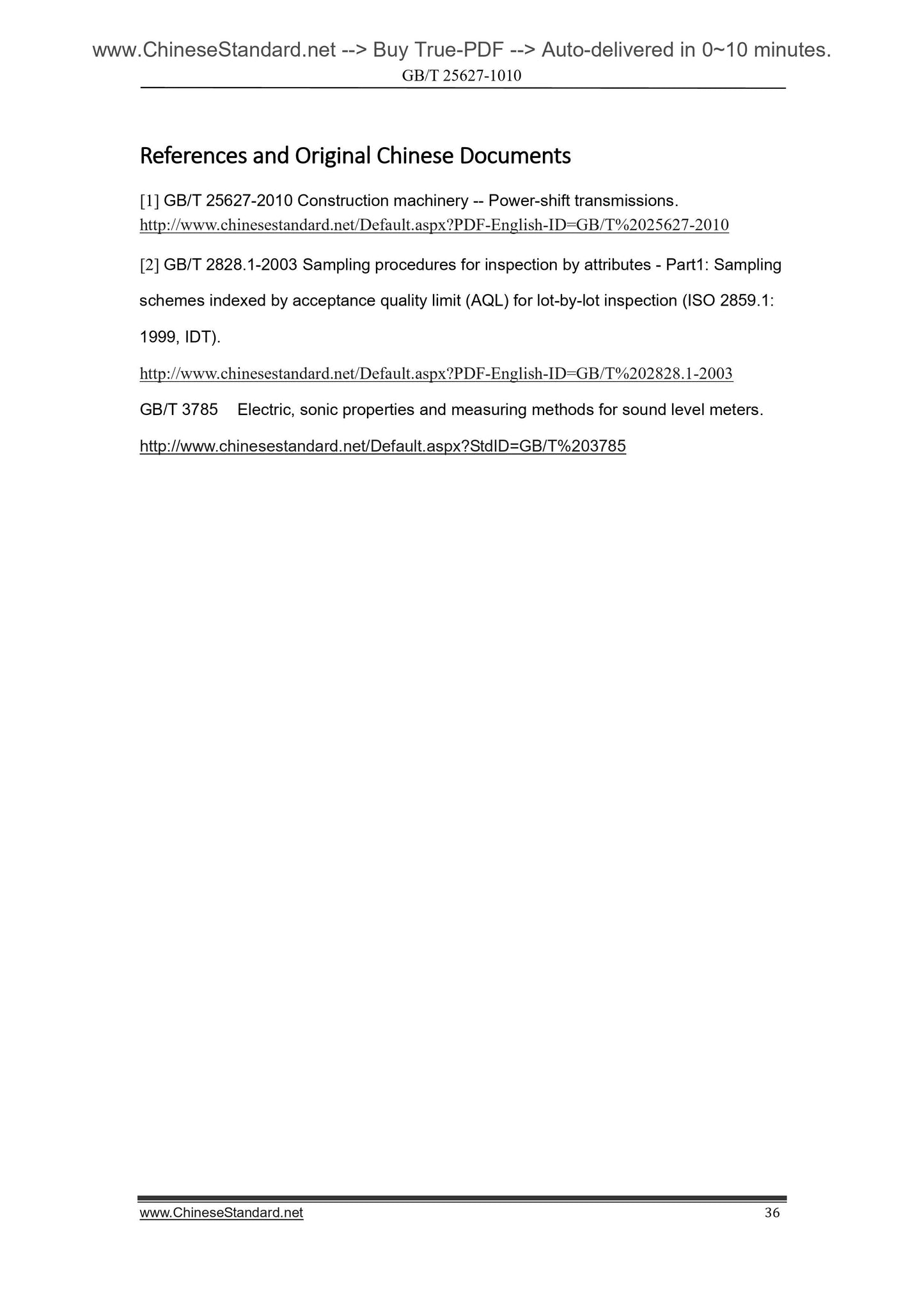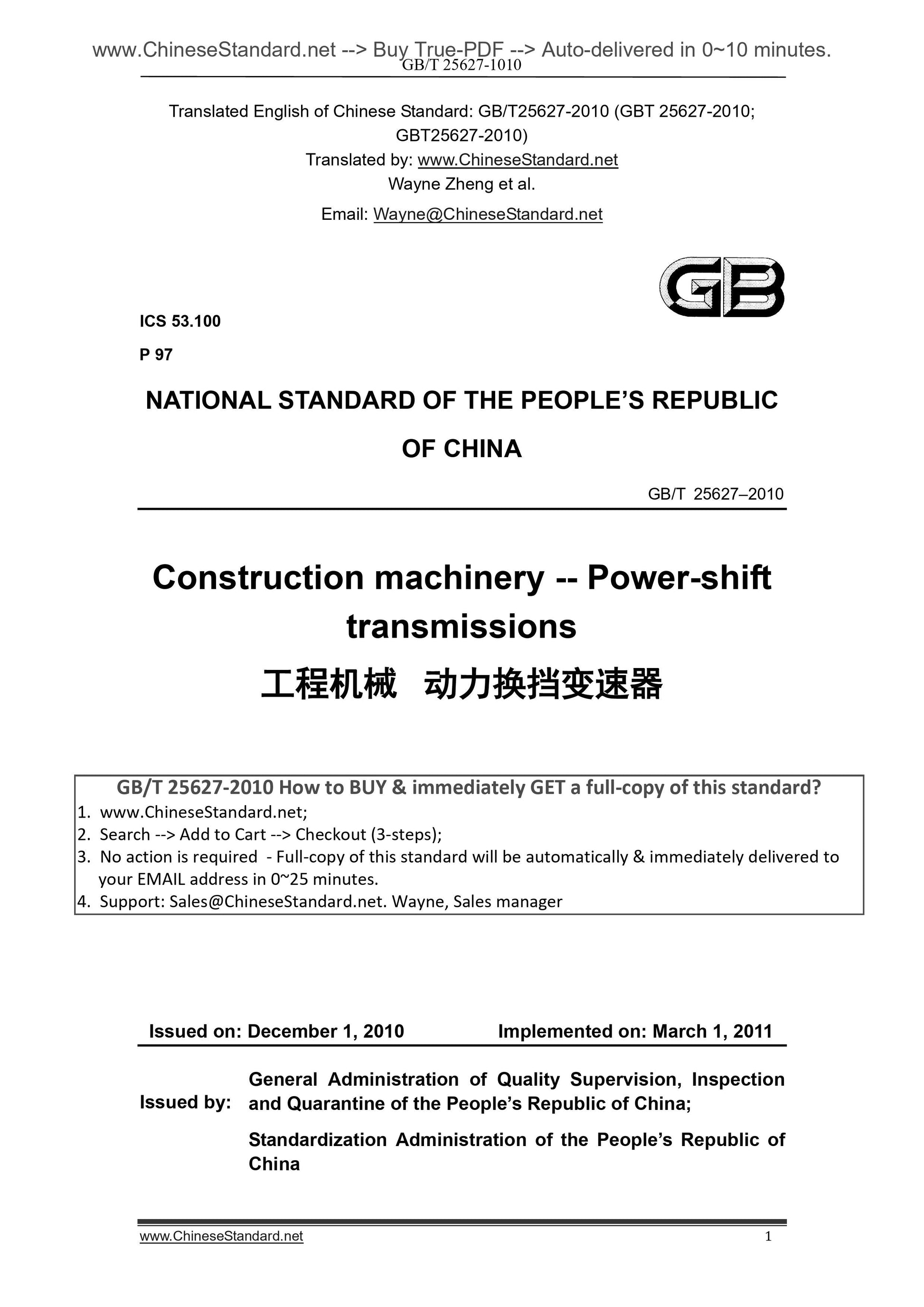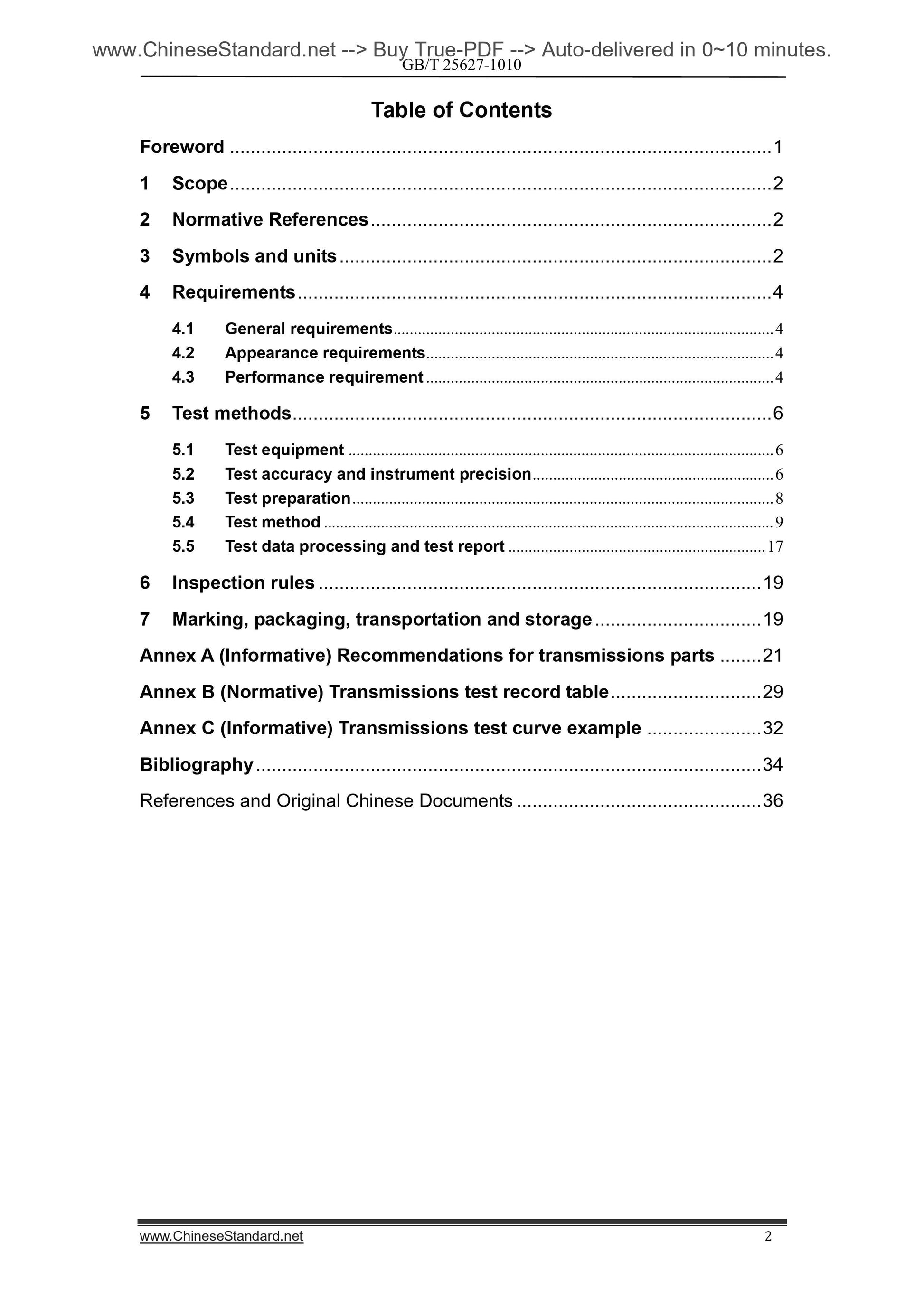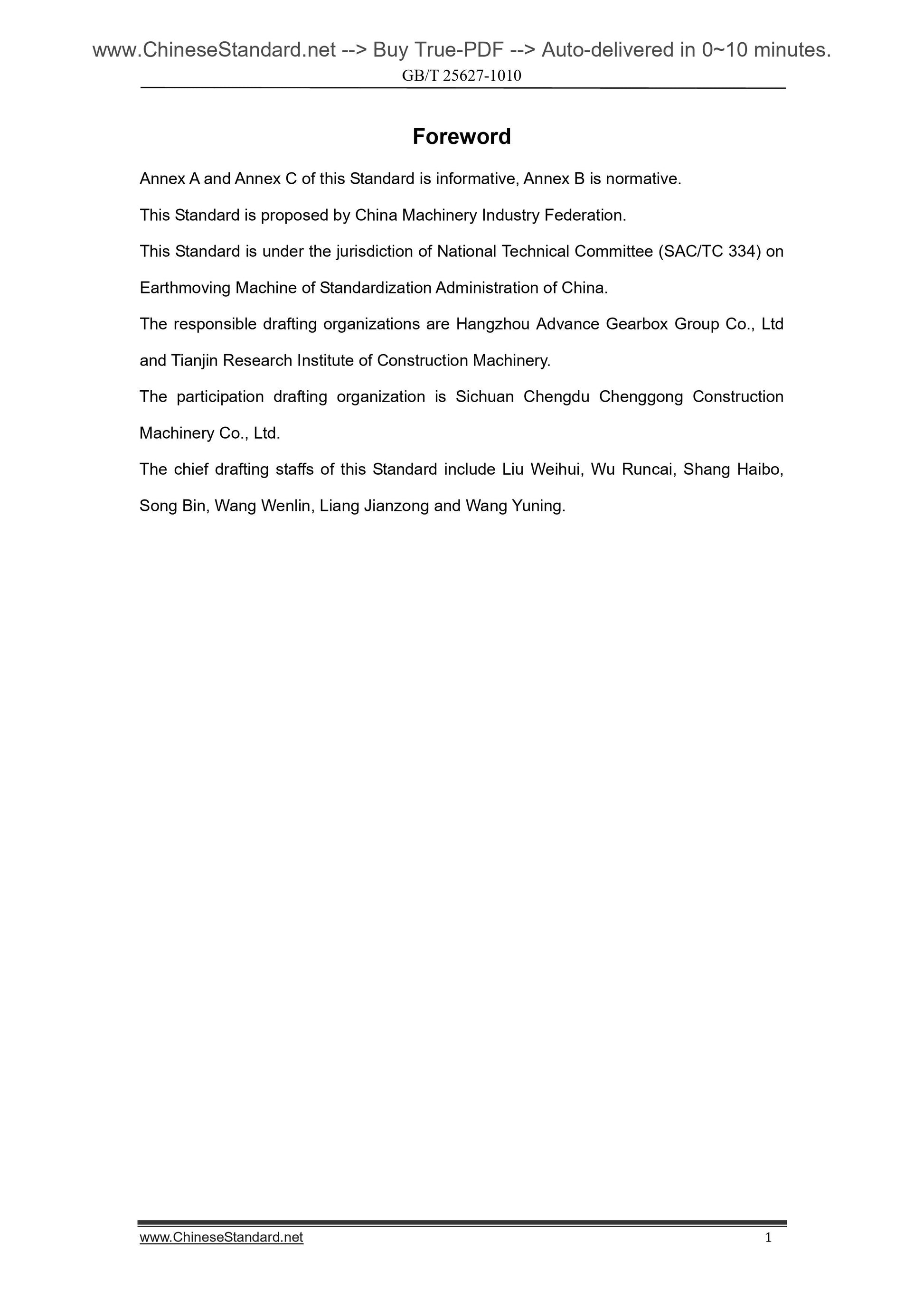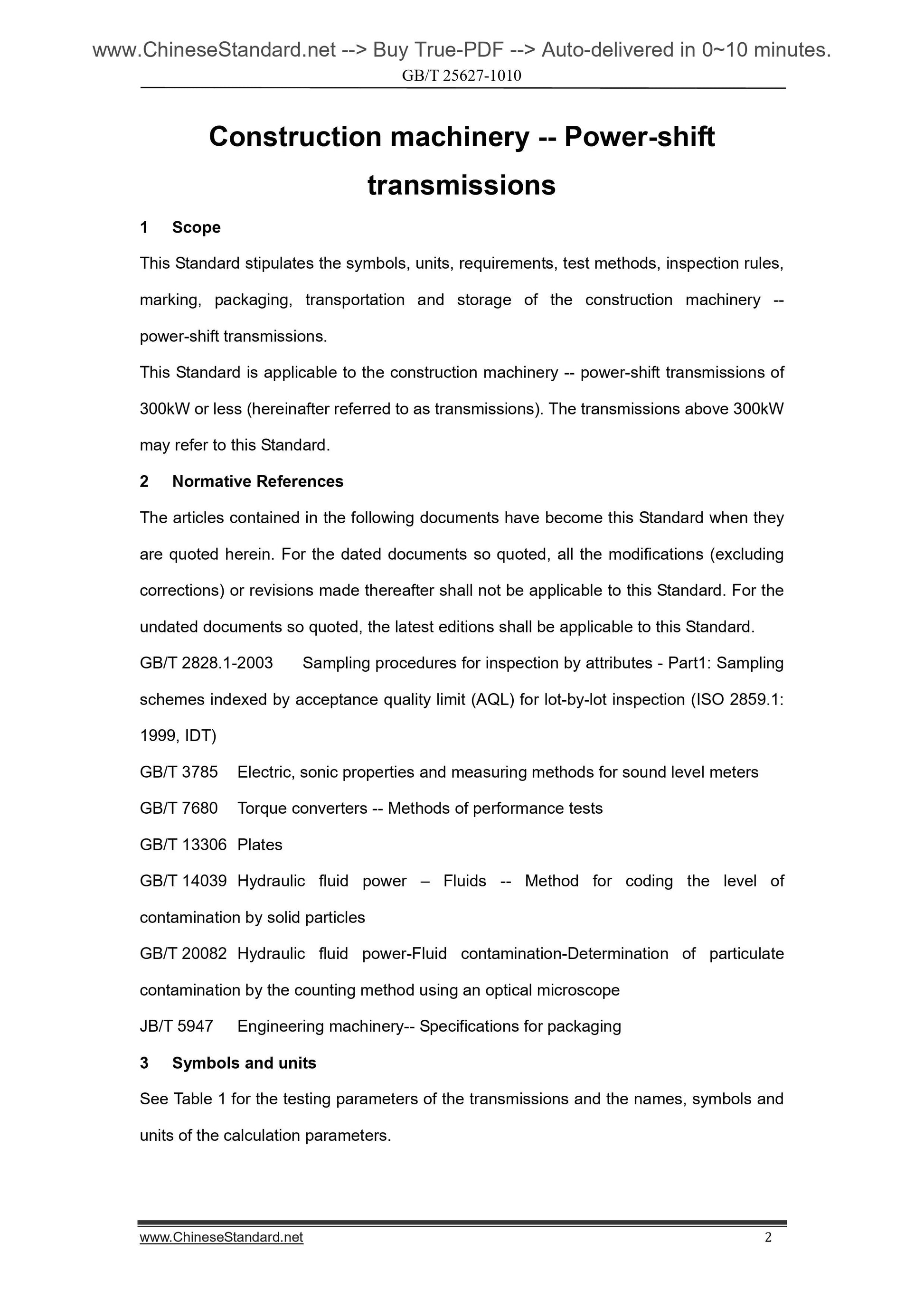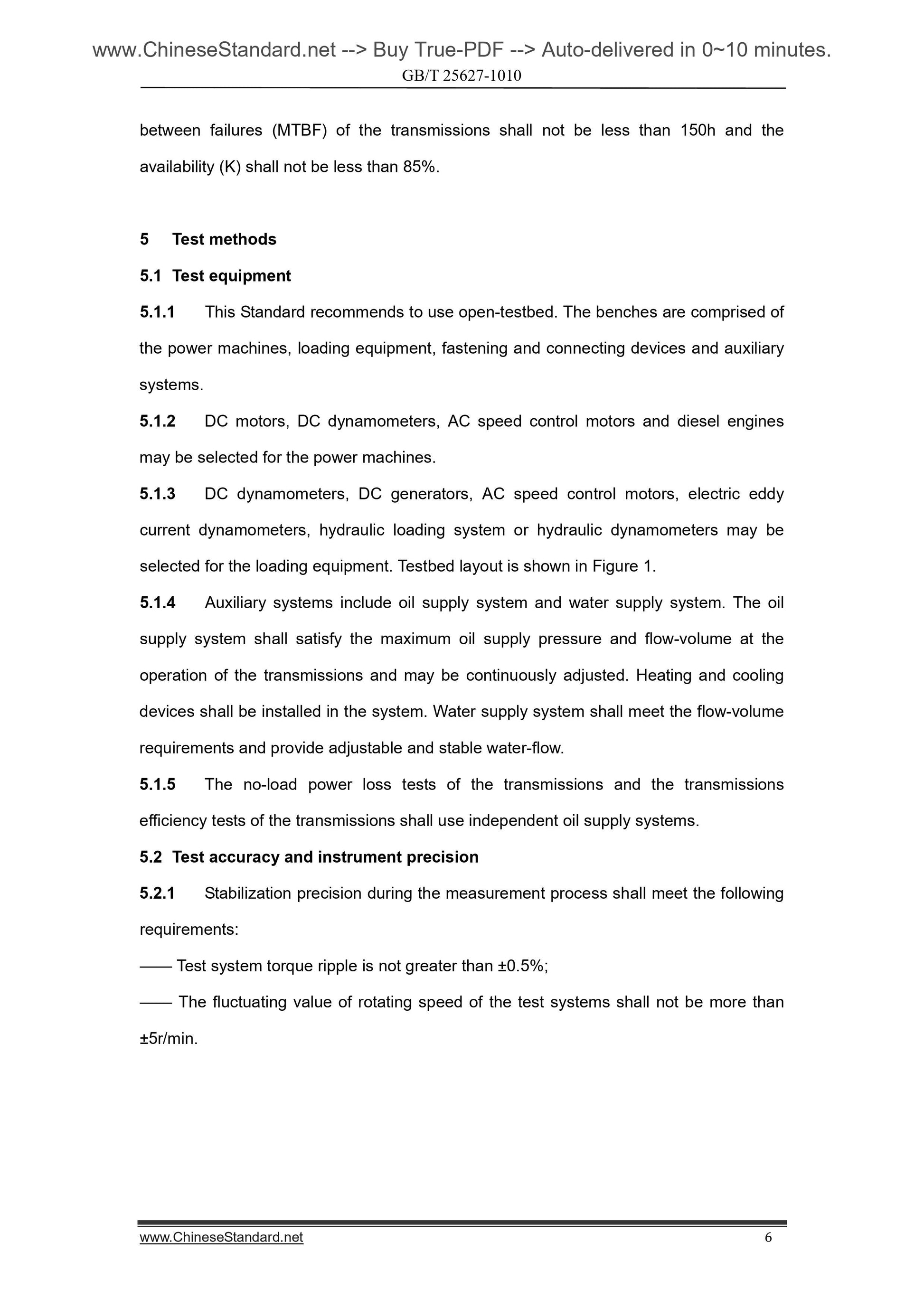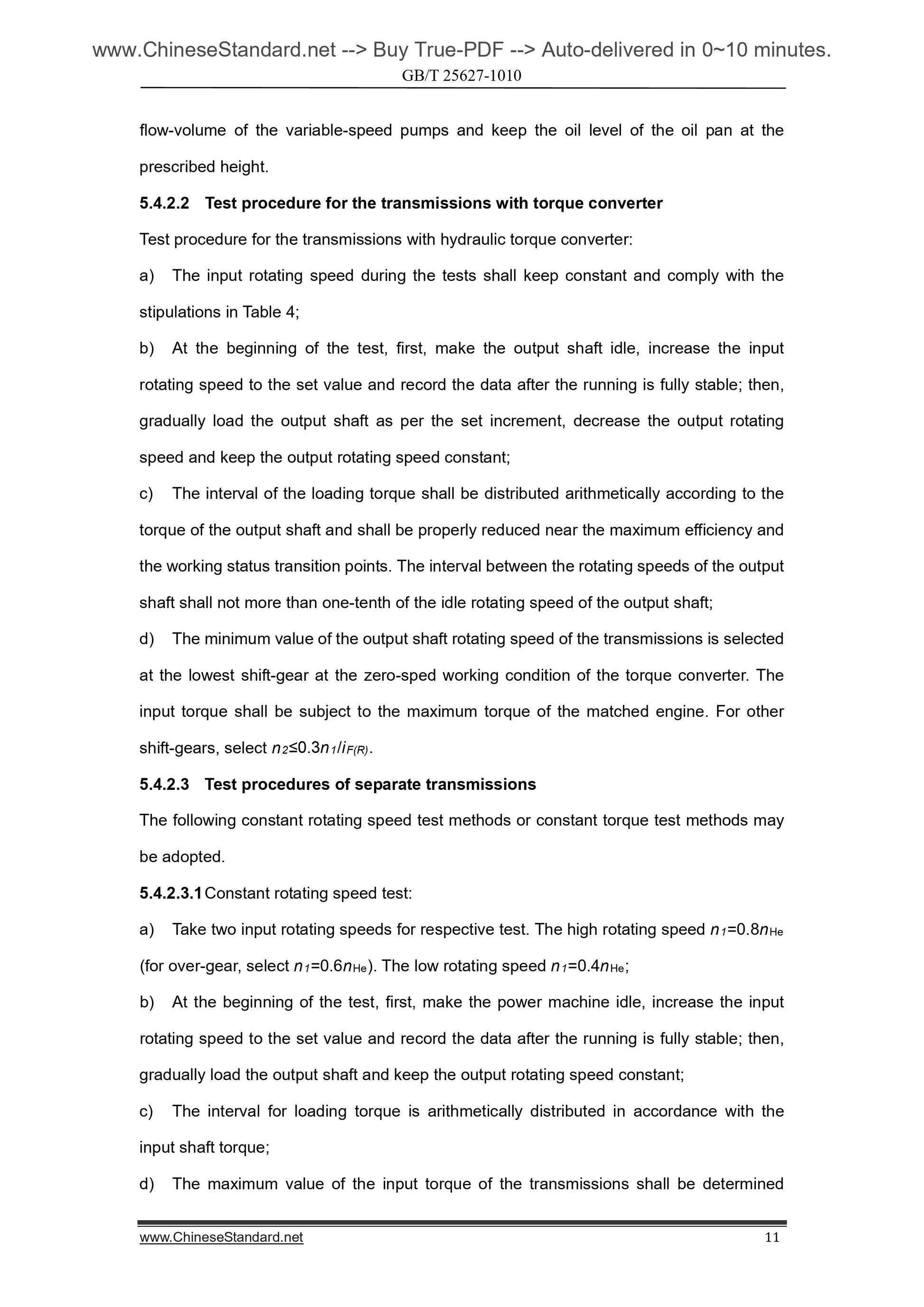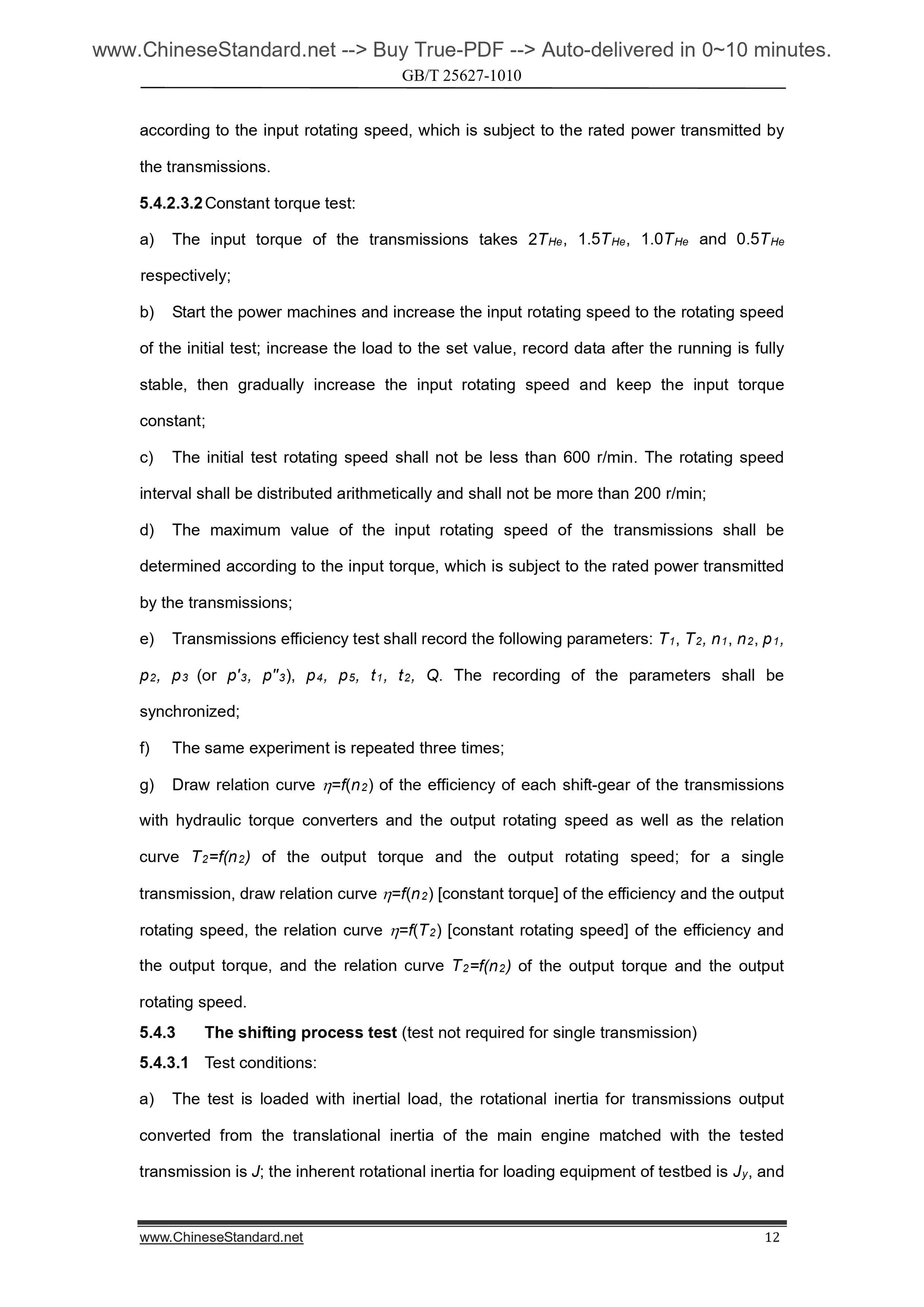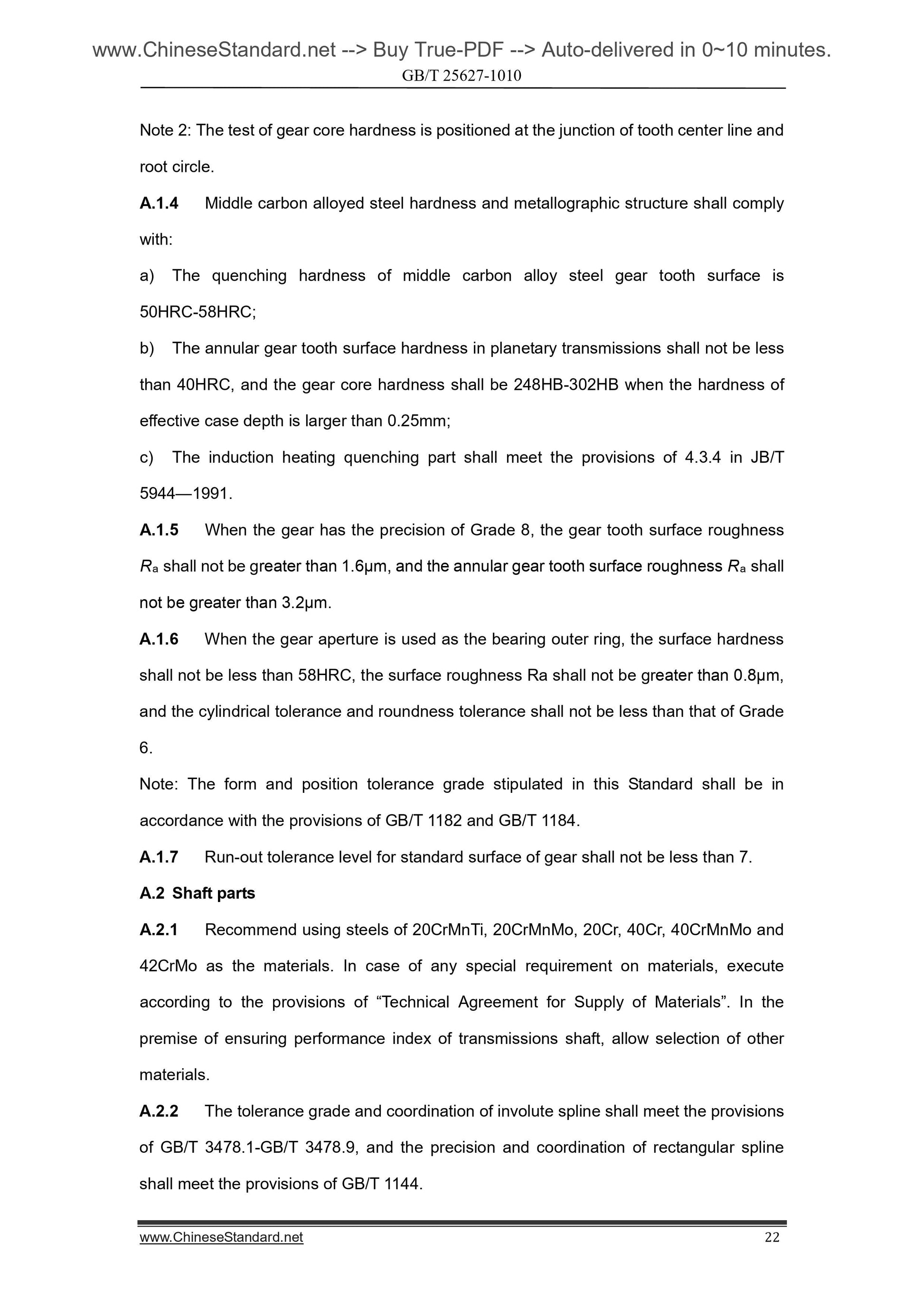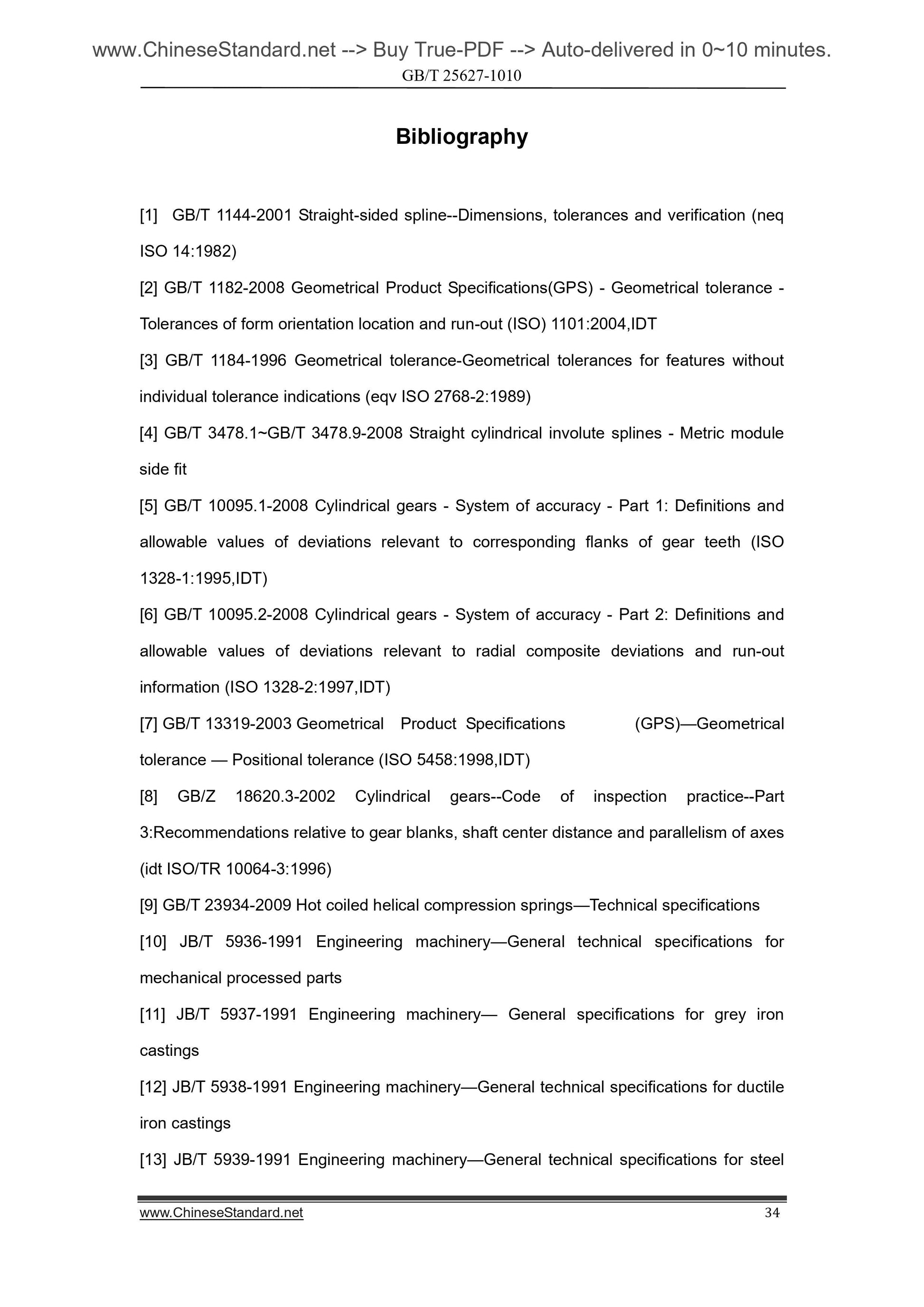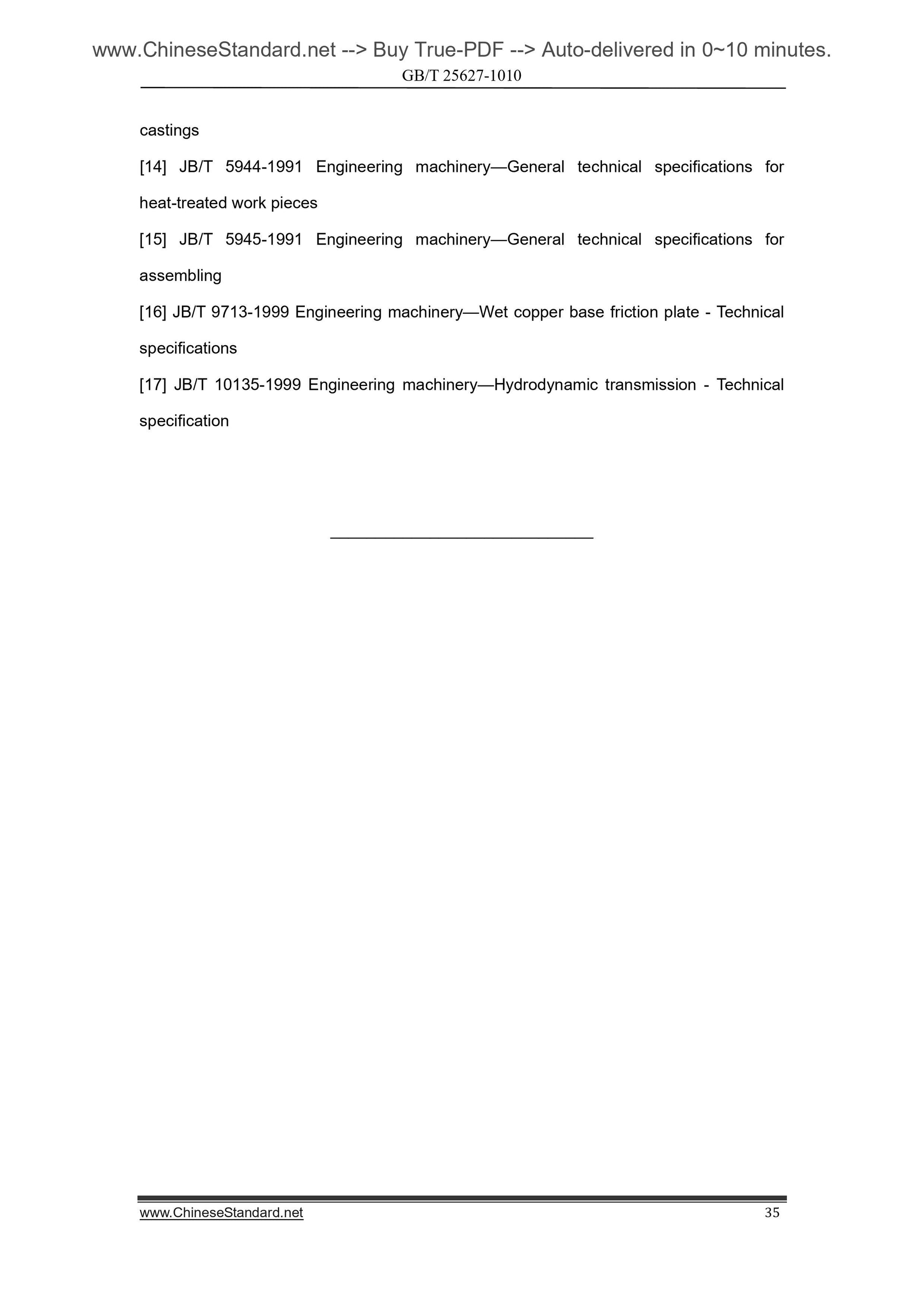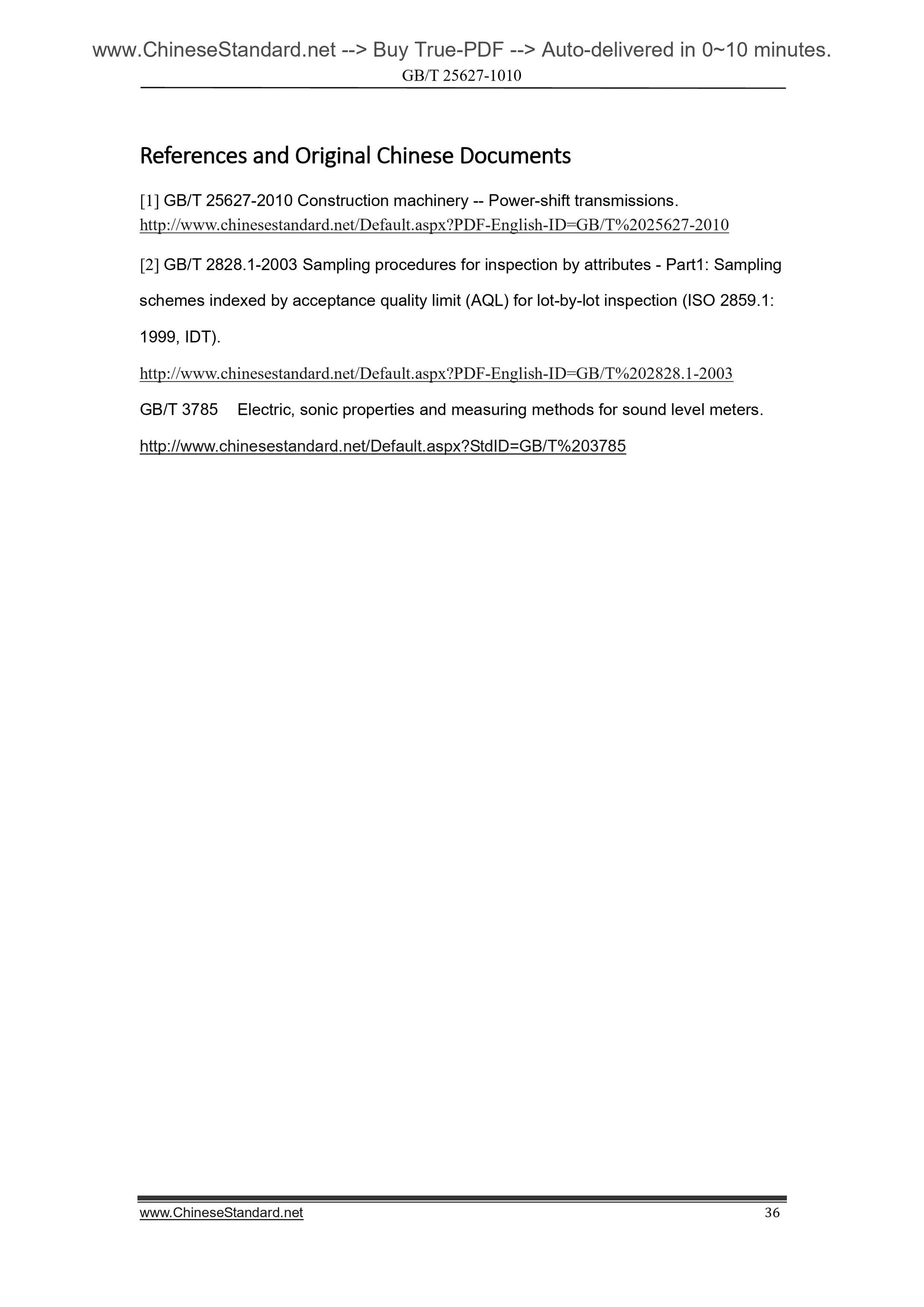1
/
of
11
PayPal, credit cards. Download editable-PDF and invoice in 1 second!
GB/T 25627-2010 English PDF (GBT25627-2010)
GB/T 25627-2010 English PDF (GBT25627-2010)
Regular price
$150.00 USD
Regular price
Sale price
$150.00 USD
Unit price
/
per
Shipping calculated at checkout.
Couldn't load pickup availability
Delivery: 3 seconds. Download true-PDF + Invoice.
Get QUOTATION in 1-minute: Click GB/T 25627-2010
Historical versions: GB/T 25627-2010
Preview True-PDF (Reload/Scroll if blank)
GB/T 25627-2010: Construction machinery -- Power-shift transmissions
GB/T 25627-1010
GBT25627-2010)
ICS 53.100
P 97
NATIONAL STANDARD OF THE PEOPLE’S REPUBLIC
OF CHINA
GB/T 25627–2010
Construction machinery -- Power-shift
transmissions
ISSUED ON. DECEMBER 1, 2010
IMPLEMENTED ON. MARCH 1, 2011
Issued by.
General Administration of Quality Supervision, Inspection
and Quarantine of the People’s Republic of China;
Standardization Administration of the People’s Republic of
China
Table of Contents
Foreword ... 1
1 Scope ... 2
2 Normative References ... 2
3 Symbols and units ... 2
4 Requirements ... 4
4.1 General requirements ... 4
4.2 Appearance requirements ... 4
4.3 Performance requirement ... 4
5 Test methods... 6
5.1 Test equipment ... 6
5.2 Test accuracy and instrument precision ... 6
5.3 Test preparation ... 8
5.4 Test method ... 9
5.5 Test data processing and test report ... 17
6 Inspection rules ... 19
7 Marking, packaging, transportation and storage ... 19
Annex A (Informative) Recommendations for transmissions parts ... 21
Annex B (Normative) Transmissions test record table ... 29
Annex C (Informative) Transmissions test curve example ... 32
Bibliography ... 34
References and Original Chinese Documents ... 36
Foreword
Annex A and Annex C of this Standard is informative, Annex B is normative.
This Standard is proposed by China Machinery Industry Federation.
This Standard is under the jurisdiction of National Technical Committee (SAC/TC 334) on
Earthmoving Machine of Standardization Administration of China.
The responsible drafting organizations are Hangzhou Advance Gearbox Group Co., Ltd
and Tianjin Research Institute of Construction Machinery.
The participation drafting organization is Sichuan Chengdu Chenggong Construction
Machinery Co., Ltd.
The chief drafting staffs of this Standard include Liu Weihui, Wu Runcai, Shang Haibo,
Song Bin, Wang Wenlin, Liang Jianzong and Wang Yuning.
Construction machinery -- Power-shift
transmissions
1 Scope
This Standard stipulates the symbols, units, requirements, test methods, inspection rules,
marking, packaging, transportation and storage of the construction machinery --
power-shift transmissions.
This Standard is applicable to the construction machinery -- power-shift transmissions of
300kW or less (hereinafter referred to as transmissions). The transmissions above 300kW
may refer to this Standard.
2 Normative References
The articles contained in the following documents have become this Standard when they
are quoted herein. For the dated documents so quoted, all the modifications (excluding
corrections) or revisions made thereafter shall not be applicable to this Standard. For the
undated documents so quoted, the latest editions shall be applicable to this Standard.
GB/T 2828.1-2003 Sampling procedures for inspection by attributes - Part1. Sampling
schemes indexed by acceptance quality limit (AQL) for lot-by-lot inspection (ISO 2859.1.
1999, IDT)
GB/T 3785 Electric, sonic properties and measuring methods for sound level meters
GB/T 7680 Torque converters -- Methods of performance tests
GB/T 13306 Plates
GB/T 14039 Hydraulic fluid power – Fluids -- Method for coding the level of
contamination by solid particles
GB/T 20082 Hydraulic fluid power-Fluid contamination-Determination of particulate
contamination by the counting method using an optical microscope
JB/T 5947 Engineering machinery-- Specifications for packaging
3 Symbols and units
See Table 1 for the testing parameters of the transmissions and the names, symbols and
units of the calculation parameters.
between failures (MTBF) of the transmissions shall not be less than 150h and the
availability (K) shall not be less than 85%.
5 Test methods
5.1 Test equipment
5.1.1 This Standard recommends to use open-testbed. The benches are comprised of
the power machines, loading equipment, fastening and connecting devices and auxiliary
systems.
5.1.2 DC motors, DC dynamometers, AC speed control motors and diesel engines
may be selected for the power machines.
5.1.3 DC dynamometers, DC generators, AC speed control motors, electric eddy
current dynamometers, hydraulic loading system or hydraulic dynamometers may be
selected for the loading equipment. Testbed layout is shown in Figure 1.
5.1.4 Auxiliary systems include oil supply system and water supply system. The oil
supply system shall satisfy the maximum oil supply pressure and flow-volume at the
operation of the transmissions and may be continuously adjusted. Heating and cooling
devices shall be installed in the system. Water supply system shall meet the flow-volume
requirements and provide adjustable and stable water-flow.
5.1.5 The no-load power loss tests of the transmissions and the transmissions
efficiency tests of the transmissions shall use independent oil supply systems.
5.2 Test accuracy and instrument precision
5.2.1 Stabilization precision during the measurement process shall meet the following
requirements.
—— Test system torque ripple is not greater than ±0.5%;
—— The fluctuating value of rotating speed of the test systems shall not be more than
±5r/min.
flow-volume of the variable-speed pumps and keep the oil level of the oil pan at the
prescribed height.
5.4.2.2 Test procedure for the transmissions with torque converter
Test procedure for the transmissions with hydraulic torque converter.
a) The input rotating speed during the tests shall keep constant and comply with the
stipulations in Table 4;
b) At the beginning of the test, first, make the output shaft idle, increase the input
rotating speed to the set value and record the data after the running is fully stable; then,
gradually load the output shaft as per the set increment, decrease the output rotating
speed and keep the output rotating speed constant;
c) The interval of the loading torque shall be distributed arithmetically according to the
torque of the output shaft and shall be properly reduced near the maximum efficiency and
the working status transition points. The interval between the rotating speeds of the output
shaft shall not more than one-tenth of the idle rotating speed of the output shaft;
d) The minimum value of the output shaft rotating speed of the transmissions is selected
at the lowest shift-gear at the zero-sped working condition of the torque converter. The
input torque shall be subject to the maximum torque of the matched engine. For other
shift-gears, select n2≤0.3n1/iF(R).
5.4.2.3 Test procedures of separate transmissions
The following constant rotating speed test methods or constant torque test methods may
be adopted.
5.4.2.3.1 Constant rotating speed test.
a) Take two input rotating speeds for respective test. The high rotating speed n1=0.8nHe
(for over-gear, select n1=0.6nHe). The low rotating speed n1=0.4nHe;
b) At the beginning of the test, first, make the power machine idle, increase the input
rotating speed to the set value and record the data after the running is fully stable; then,
gradually load the output shaft and keep the output rotating speed constant;
c) The interval for loading torque is arithmetically distributed in accordance with the
input shaft torque;
d) The maximum value of the input torque of the transmissions shall be determined
according to the input rotating speed, which is subject to the rated power transmitted by
the transmissions.
5.4.2.3.2 Constant torque test.
a) The input torque of the transmi...
Get QUOTATION in 1-minute: Click GB/T 25627-2010
Historical versions: GB/T 25627-2010
Preview True-PDF (Reload/Scroll if blank)
GB/T 25627-2010: Construction machinery -- Power-shift transmissions
GB/T 25627-1010
GBT25627-2010)
ICS 53.100
P 97
NATIONAL STANDARD OF THE PEOPLE’S REPUBLIC
OF CHINA
GB/T 25627–2010
Construction machinery -- Power-shift
transmissions
ISSUED ON. DECEMBER 1, 2010
IMPLEMENTED ON. MARCH 1, 2011
Issued by.
General Administration of Quality Supervision, Inspection
and Quarantine of the People’s Republic of China;
Standardization Administration of the People’s Republic of
China
Table of Contents
Foreword ... 1
1 Scope ... 2
2 Normative References ... 2
3 Symbols and units ... 2
4 Requirements ... 4
4.1 General requirements ... 4
4.2 Appearance requirements ... 4
4.3 Performance requirement ... 4
5 Test methods... 6
5.1 Test equipment ... 6
5.2 Test accuracy and instrument precision ... 6
5.3 Test preparation ... 8
5.4 Test method ... 9
5.5 Test data processing and test report ... 17
6 Inspection rules ... 19
7 Marking, packaging, transportation and storage ... 19
Annex A (Informative) Recommendations for transmissions parts ... 21
Annex B (Normative) Transmissions test record table ... 29
Annex C (Informative) Transmissions test curve example ... 32
Bibliography ... 34
References and Original Chinese Documents ... 36
Foreword
Annex A and Annex C of this Standard is informative, Annex B is normative.
This Standard is proposed by China Machinery Industry Federation.
This Standard is under the jurisdiction of National Technical Committee (SAC/TC 334) on
Earthmoving Machine of Standardization Administration of China.
The responsible drafting organizations are Hangzhou Advance Gearbox Group Co., Ltd
and Tianjin Research Institute of Construction Machinery.
The participation drafting organization is Sichuan Chengdu Chenggong Construction
Machinery Co., Ltd.
The chief drafting staffs of this Standard include Liu Weihui, Wu Runcai, Shang Haibo,
Song Bin, Wang Wenlin, Liang Jianzong and Wang Yuning.
Construction machinery -- Power-shift
transmissions
1 Scope
This Standard stipulates the symbols, units, requirements, test methods, inspection rules,
marking, packaging, transportation and storage of the construction machinery --
power-shift transmissions.
This Standard is applicable to the construction machinery -- power-shift transmissions of
300kW or less (hereinafter referred to as transmissions). The transmissions above 300kW
may refer to this Standard.
2 Normative References
The articles contained in the following documents have become this Standard when they
are quoted herein. For the dated documents so quoted, all the modifications (excluding
corrections) or revisions made thereafter shall not be applicable to this Standard. For the
undated documents so quoted, the latest editions shall be applicable to this Standard.
GB/T 2828.1-2003 Sampling procedures for inspection by attributes - Part1. Sampling
schemes indexed by acceptance quality limit (AQL) for lot-by-lot inspection (ISO 2859.1.
1999, IDT)
GB/T 3785 Electric, sonic properties and measuring methods for sound level meters
GB/T 7680 Torque converters -- Methods of performance tests
GB/T 13306 Plates
GB/T 14039 Hydraulic fluid power – Fluids -- Method for coding the level of
contamination by solid particles
GB/T 20082 Hydraulic fluid power-Fluid contamination-Determination of particulate
contamination by the counting method using an optical microscope
JB/T 5947 Engineering machinery-- Specifications for packaging
3 Symbols and units
See Table 1 for the testing parameters of the transmissions and the names, symbols and
units of the calculation parameters.
between failures (MTBF) of the transmissions shall not be less than 150h and the
availability (K) shall not be less than 85%.
5 Test methods
5.1 Test equipment
5.1.1 This Standard recommends to use open-testbed. The benches are comprised of
the power machines, loading equipment, fastening and connecting devices and auxiliary
systems.
5.1.2 DC motors, DC dynamometers, AC speed control motors and diesel engines
may be selected for the power machines.
5.1.3 DC dynamometers, DC generators, AC speed control motors, electric eddy
current dynamometers, hydraulic loading system or hydraulic dynamometers may be
selected for the loading equipment. Testbed layout is shown in Figure 1.
5.1.4 Auxiliary systems include oil supply system and water supply system. The oil
supply system shall satisfy the maximum oil supply pressure and flow-volume at the
operation of the transmissions and may be continuously adjusted. Heating and cooling
devices shall be installed in the system. Water supply system shall meet the flow-volume
requirements and provide adjustable and stable water-flow.
5.1.5 The no-load power loss tests of the transmissions and the transmissions
efficiency tests of the transmissions shall use independent oil supply systems.
5.2 Test accuracy and instrument precision
5.2.1 Stabilization precision during the measurement process shall meet the following
requirements.
—— Test system torque ripple is not greater than ±0.5%;
—— The fluctuating value of rotating speed of the test systems shall not be more than
±5r/min.
flow-volume of the variable-speed pumps and keep the oil level of the oil pan at the
prescribed height.
5.4.2.2 Test procedure for the transmissions with torque converter
Test procedure for the transmissions with hydraulic torque converter.
a) The input rotating speed during the tests shall keep constant and comply with the
stipulations in Table 4;
b) At the beginning of the test, first, make the output shaft idle, increase the input
rotating speed to the set value and record the data after the running is fully stable; then,
gradually load the output shaft as per the set increment, decrease the output rotating
speed and keep the output rotating speed constant;
c) The interval of the loading torque shall be distributed arithmetically according to the
torque of the output shaft and shall be properly reduced near the maximum efficiency and
the working status transition points. The interval between the rotating speeds of the output
shaft shall not more than one-tenth of the idle rotating speed of the output shaft;
d) The minimum value of the output shaft rotating speed of the transmissions is selected
at the lowest shift-gear at the zero-sped working condition of the torque converter. The
input torque shall be subject to the maximum torque of the matched engine. For other
shift-gears, select n2≤0.3n1/iF(R).
5.4.2.3 Test procedures of separate transmissions
The following constant rotating speed test methods or constant torque test methods may
be adopted.
5.4.2.3.1 Constant rotating speed test.
a) Take two input rotating speeds for respective test. The high rotating speed n1=0.8nHe
(for over-gear, select n1=0.6nHe). The low rotating speed n1=0.4nHe;
b) At the beginning of the test, first, make the power machine idle, increase the input
rotating speed to the set value and record the data after the running is fully stable; then,
gradually load the output shaft and keep the output rotating speed constant;
c) The interval for loading torque is arithmetically distributed in accordance with the
input shaft torque;
d) The maximum value of the input torque of the transmissions shall be determined
according to the input rotating speed, which is subject to the rated power transmitted by
the transmissions.
5.4.2.3.2 Constant torque test.
a) The input torque of the transmi...
Share
